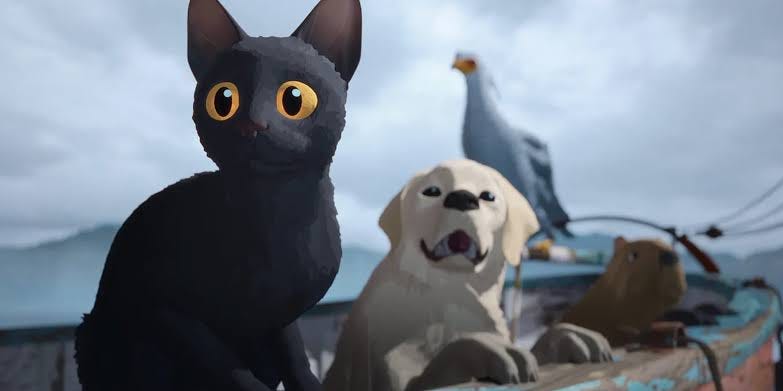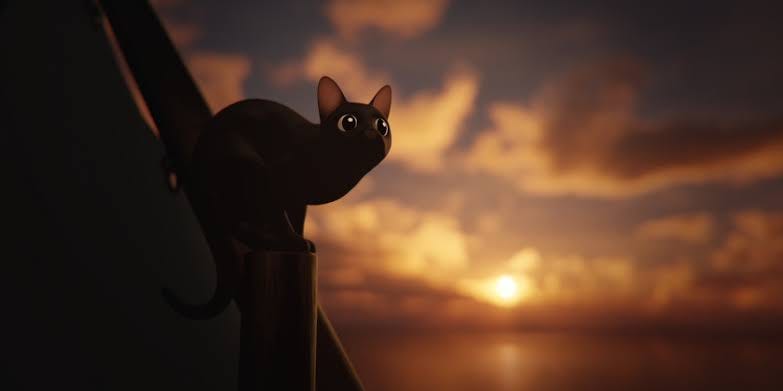Flow’s visual narrative and style : interview with animation director Léo Silly Pélissier
On the animation style of the film
Flow is about a solitary cat whose home is devastated by a great flood, and has to find refuge on a boat populated by various species, with whom the cat has to team up with despite their differences. It takes place in a fantasy world, in a place apparently deserted by humans. We asked the animation director, Léo Silly Pélissier, few questions about the film’s animation style, collaborating with the film's director Gints Zilbalodis, and working with a wordless scenario.
How did this collaboration with Gints Zilbalodis first start?
I was introduced to Gints Zilbalodis by Virginie Guilminot, she was production director of Sacrebleu and we have already worked together a couple of times. I knew Gints had his own style and that he was used to working alone. Thanks to my experience in animation with different authors, my technical and artistical approach, I was able to adapt to his style and bring my knowledge, which reassured him.
We quickly got on the same page and started developing the animation :).
Flow’s visual style is a hybridisation between 3D animation and video game cinematics. Can you walk us through the production process and the blender workflow you and your team used ?
Gints Zilbalodis worked on his style to find a good balance between the beauty and the sobriety. I’m not sure that He was inspired by video games but I know that He wanted to focus on the relation between characters, to how they manage to be together, to how they react. Because the animals don’t talk, the communication between them is very subtle and making a realistic visual style with fur and a lot of details would be more disturbing than efficient.
Technically, with this visual style we saved a lot of time for the rendering because all was Real Time rendered in Blender, and we can manage to finish Flow according to our time and budget.
About the animation workflow, the goal was to be efficient enough to make the animation with a short time and a small team (20 animators in 6 months).
To do that, I worked before the production for preparing the animation (style, method, puppets..) and well dispatching all the sequences and shots according to the difficulty of each one. I also looked for technical and artistic solutions to manage the big shots and the naturalistic style of the movie. Blender was again very helpful and offers many possibilities to handle it.
© Flow
The animated film is not only unique visually speaking, but also in terms of storytelling with its silent narrative. How was it working with a wordless scenario? And how did you build an animation that only relies on visual language yet captivates the audience emotionally with zero dialogues?
It's a radical choice, but well directed, it can be very strong to communicate things and ideas, in a way, the spectator has to be more focused on what's happening !
The art direction and the staging of the director Gints Zilbalodis are very powerful, and he did the same in his previous projects. He always said that he’s not comfortable with dialogues, so he transformed his weakness into a force !
In the film, we follow the story of a cat and its other animal camarades who try to survive a great flood in a place apparently deserted by humans. The animal characters aren't stand-ins for human stereotypes as we usually see in animated films that involve animals. They don't mimic or behave like humans, they are true representations of their own species in terms of mouvements and behaviours. How did you achieve that exactitude in character designs?
In a way, this question and the previous one are linked, because one of the biggest interests of the film is to have chosen a naturalistic style for the movements of the characters, avoiding the cartoonish style, usually used in animated film.
As an animation director, I thought of this project like a documentary movie.
A story without dialogues forces us to communicate through body language, as all animals naturally do in real life.
I wanted to reproduce the same reaction for the audience as when you look at an animal (your cat for example) and try to guess what he’s thinking, what he wants, what he’s trying to say.
So, I gathered many video and photo references to well reproduce their movements and facial expressions, then created an animation guide and animation rules/methods to give animators everything they need to bring animal characters to life and make their movements interesting.
© Flow
Other than character design, there is also the background animation, the nature and places in which we see the characters move. Besides flow happening in a sort of fantasy world, does this place geographically exist?
I can’t say specifically which references Gints used, many of them make me think about real places like Venezia for the drowned city, Meteors area in Greece or some Himalaya’s places for mountainside temple-houses with the grand staircase climbing up to the top of the mountain.
In other matters, the places and nature play a very important role in the story.
And particularly the water!
Gints built a kind of living earth, with their own rules, and its own functioning, disturbing the life of the animals and constraining them to move on and to surpass themselves.
The background is full CG made by the latvian team, and they also worked on FX animation to make the nature and element realistic and modular.
As the story and films move forward the colors get darker. Can you explain the overall chosen color scheme/color grading that you decided upon throughout the film?
The dark color is due to the weather, the more the characters move on, the more they approach the big storm, to the moment that they have to face their destiny.
It doesn't mean that it’s bad or good, but things happen and they have to follow their heart, their instinct.
Interview and cover by Yamina.H






